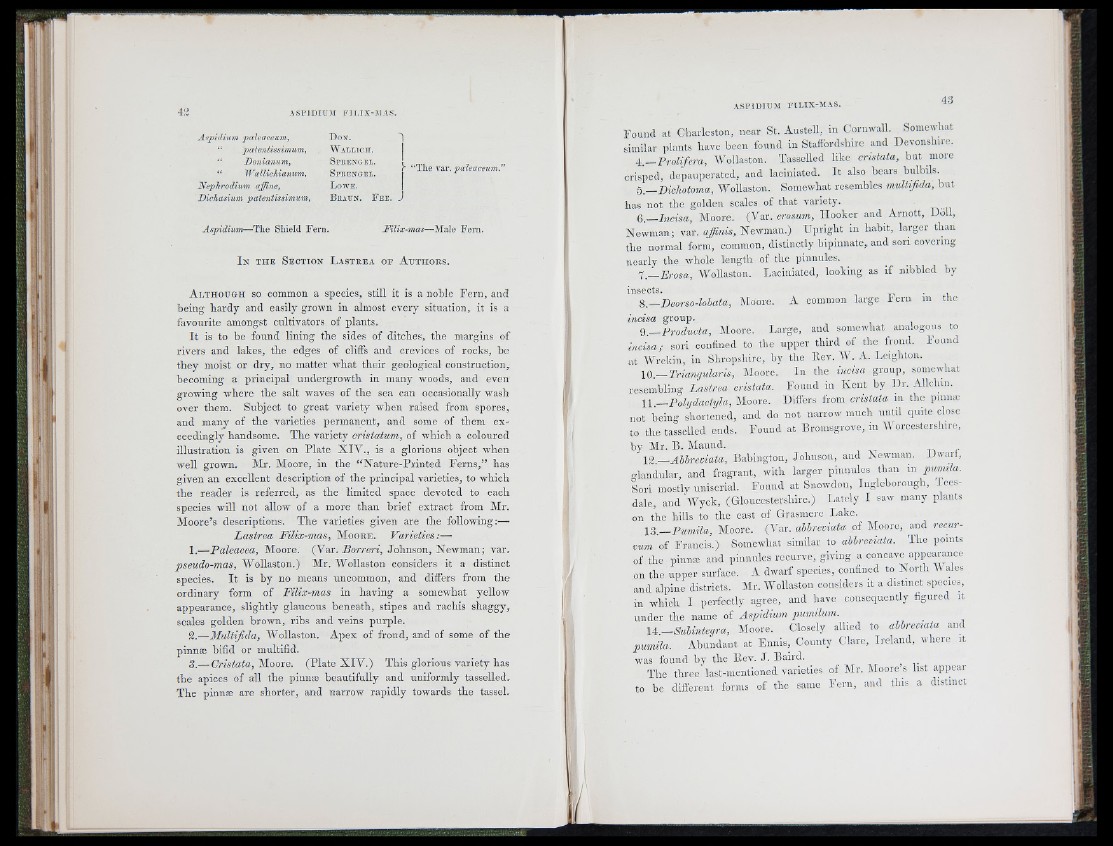
t:
i;
42 ASPIDIUM FIUX-MAS.
A sp iilium palracewm, D o n .
“ p ateniissiinum, W a l l ic it .
“ Donianum, S p e e n g e l .
“ WalUcJàanum, S p e e n g e l .
Nephrodium. affine, L o w e .
Piehasium patentissimum, B e a g n . B e e . J
■ “Tlie var. paleaceum."
Aspidium—The Shield Fern. Filix-mas—Male Fern.
I n t h e S e c t io n L a s t r e a o f A u t h o r s .
A l t h o u g h so common a species, still it is a noble Fern, and
being hardy and easily grown in almost every situation, it is a
favourite amongst cultivators of plants.
I t is to he found lining the sides of ditches, the margins of
rivers and lakes, the edges of cliffs and crevices of rocks, he
they moist or dry, no matter what their geological construction,
becoming a principal undergrowth in many woods, and even
growing where the salt waves of the sea can occasionally wash
over them. Subject to great variety when raised from spores,
and many of the varieties permanent, and some of them exceedingly
handsome. The variety cristatum, of which a coloured
illustration is given on Plate X IV ., is a glorious object when
well grown. Mr. Moore, in the “ Nature-Printed Ferns,” has
given an excellent description of the principal varieties, to which
the reader is referred, as the limited space devoted to each
species will not allow of a more than brief extract from Mr.
Moore’s descriptions. The varieties given are the following:—
Lastrea Filix-mas, M o o e e . Varieties:—
1.— Paleacea, Moore. (Var. iJ o r rm , Johnson, Newman; var.
pseudo-mas, Wollaston.) Mr. Wollaston considers it a distinct
species. I t is by no means uncommon, and differs from the
ordinary form of Filix-mas in having a somewhat yellow
appearance, slightly glaucous beneath, stipes and rachis shaggy,
scales golden brown, ribs and veins purple.
2.—Multifida, Wollaston. Apex of frond, and of some of the
pinnæ bifid or multifid.
3 .— Cristata, Moore. (Plate X IV .) This glorious variety has
the apices of all the pinnæ beautifully and uniformly tasselled.
The pinnæ are shorter, and narrow rapidly towards the tassel.
A S P ID IU M F IL IX -M A S . 4.3
Found at Charleston, near St. Austell, in Cornwall. Somewhat
similar plants have been found in Staifordshirc and Devonshire.
4 — Prolifera, lYollaston. Tasselled like cristata, bnt more
crisped, depauperated, and laoiuiatcd. I t also bears bulbils.
b.— Dichotoma, Wollaston. Somewhat resembles multifida, but
has not the golden scales of that variety.
(S.— Incisa, Moore, ( y -ax. erosum. Hooker and Arnott, Doll,
Newman; v a r . Newman.) Upright in habit, larger than
the normal form, common, distinctly bipinnate, and sori covering
nearly the whole length of the pinnules.
f .— Erosa, Wollaston. Laciniated, looking as if nibbled by
insects.
S.— Deorso-lobata, Moore. A common large l e n i in the
incisa group.
(j,— Producta, Moore. Large, and somewhat analogous to
incisa; sori confined to the upper third of the frond. Found
at Wrckin, in Shropshire, by the Rev. W. A. Leighton.
10.— Triangularis, Moore. In the incisa group, somewhat
resembling Lastrea cristata. Found in Kent by Ur. Allclnii.
\ \ .— PolydacUjla, Moore. Uifi’ers from cristata in the pmuæ
not being shortened, and do not narrow much until quite close
to the tasselled ends. Found at Bromsgrovc, in V orcostershire,
by Mr. B. Maund. ^
lO — M lre v ia ta , Babiugton, Johnson, and Newman. Dwart,
olandular, and fragrant, with larger pinnules than in pMmila.
Sori mostly uniserial. Found at Snowdon, Ingleborough, ices-
dale, and IVyck, (Gloucestershire.) Lately I saw many plants
on Üre hills to the east of Grasmere Lake.
13.— Pumila, Moore. (Var. ahbremata of (Moore, and recur-
rum of Francis.) Somewhat similar to^ ahhreviata. The points
of the pinnæ and pinnules recurve, giving a concave appearance
on the upper surface. A dwarf species, confined to North Wales
and alpine districts. Mr. Wollaston considers it a distinct species,
in which I perfectly agree, and have consequently figured it
under the name of Aspidium pumilum.
X T -S u bm te q ra , Moore. Closely allied to aUreuata and
pumüa. Abu'ndant at Ennis, County Clare, Ireland, where it
was found by the Rev. J. Baird.
The three last-mentioned varieties of Mr. (Moore s list apimar
to be difi’erent forms of the same Fern, aud this a distinct
'i .TL'i